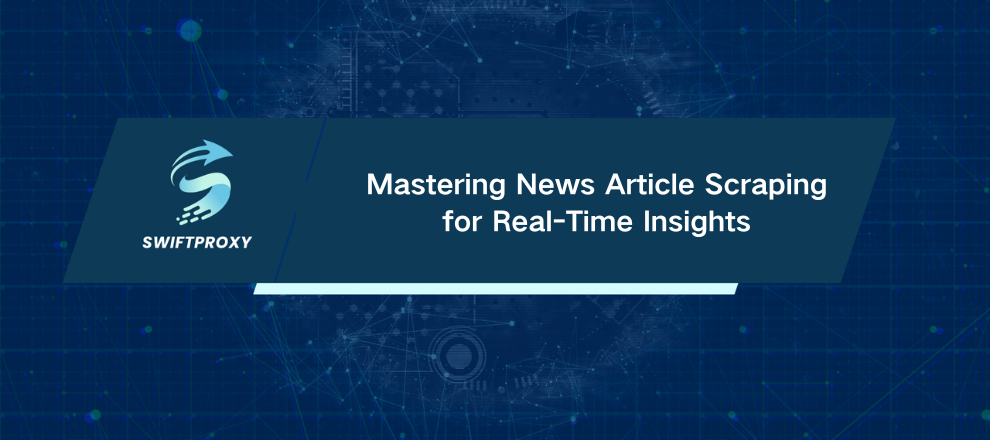Mastering News Article Scraping for Real-Time Insights

More than 500 million news articles are published online every day. That's a tidal wave of information crashing into every industry—from finance to media, research to marketing. If you're still manually hunting for news data, you're missing out. The sheer speed and volume of news demand automation—and smart automation at that.
Scraping news articles isn't just about grabbing headlines; it's about capturing real-time insights, tracking sentiment shifts, and turning raw content into actionable intelligence. However, news websites are some of the toughest to scrape, with paywalls, anti-bot technologies, and geo-blocks all working to keep you out. Getting past these hurdles takes more than luck—it requires a clear plan. Here's a look at how to build a bulletproof news scraper from the ground up.
Understanding Article Scraper
Think of an article scraper as a specialized data miner for news. It crawls websites, extracts headlines, authors, timestamps, full texts—everything you need to turn chaotic web pages into neat, structured data. Not just text, but metadata, categories, even sentiment analysis when paired with AI.
Here's what it pulls:
Article title
Publication date and time
Author name
Full article body
Tags or categories
Source URL
Once structured, this data plugs into dashboards, AI models, or research databases. Instant insight, no manual copy-paste required.
The Importance of Scraping News Articles
News data fuels critical decisions. Here's how:
Media Monitoring: Track brand mentions and competitor news in real-time.
Market Intelligence: Spot financial trends and investor sentiment before markets react.
Trendspotting: Discover emerging topics, tech breakthroughs, or social movements early.
Academic Research: Gather massive datasets for machine learning or natural language processing.
Content Aggregation: Power news feeds, dashboards, and apps with fresh headlines instantly.
Manual collection? Too slow, too error-prone, and too costly. Automation delivers speed, scale, and consistency. You can monitor hundreds of sources simultaneously with minimal human effort.
The Harsh Realities of News Article Scraping
Looks simple? It's not. News sites fight back with:
Anti-Bot Shields: CAPTCHAs, IP bans, and fake content traps.
Rate Limits: Scrape too fast, and your IP gets throttled or blocked.
JavaScript Loading: Many articles load dynamically, requiring headless browsers like Playwright.
Paywalls: Premium outlets block content behind subscriptions.
Geo-Restrictions: Content varies by your IP location.
Constant Layout Changes: Different publishers, different page structures, different headaches.
This is why a solid proxy strategy isn't optional—it's essential.
The Anatomy of a News Scraper
To build a scraper that lasts, you need these parts working in harmony:
Crawler: Finds and fetches URLs. Scrapy or Playwright are top choices.
Proxy Layer: Routes traffic through rotating IPs. Swiftproxy fits here perfectly.
Parser: Extracts headlines, dates, authors, and content. BeautifulSoup or AI extractors do the trick.
Renderer (If Needed): Handles JavaScript-heavy pages using Playwright or Puppeteer.
Data Storage: Saves data in JSON, CSV, or databases like MongoDB.
Scheduler: Runs scrapes on a regular cycle. Cron jobs or task queues work here.
Post-Processing: Summarizes, tags, or analyzes sentiment with AI or LLMs.
Put it all together, and you get a robust pipeline ready to pull massive volumes of news—fast and clean.
How to Scrape News Like a Pro
1. Pick Your News Sources: Start small. Pick 3-5 trusted publishers and grow from there.
2. Set Up Proxies: Create a Swiftproxy account, grab your API keys, and configure your scraper to route requests through residential or mobile IPs.
3. Crawl & Render: Use Scrapy or Playwright to load article pages fully—even the ones powered by JavaScript.
4. Parse Key Data: Extract title, author, date, and article body with BeautifulSoup or equivalent.
5. Handle Pagination: If articles split across pages or use infinite scroll, script your crawler to capture everything.
6. Store Data: Format and save as JSON, CSV, or push into a database.
7. Automate & Monitor: Schedule scrapes regularly. Track IP usage and success rates. Adjust as needed.
Follow this workflow, and your scraper will run like a well-oiled machine.
Best Tools for News Scraping
Scrapy: Flexible, powerful crawler framework for Python.
BeautifulSoup: Simple HTML parser for quick extractions.
Playwright / Puppeteer: Headless browsers for JavaScript-heavy sites.
Newspaper3k: Tailored for news, extracts metadata with minimal setup.
Diffbot: ML-powered API for structured article data—no coding needed.
Pick what fits your scale and complexity.
Scraping Ethically and Legally
Scraping isn't a free-for-all. Play by the rules:
Respect robots.txt as a guideline.
Check Terms of Service; avoid violating contracts.
Steer clear of paywalls unless authorized.
Use data responsibly—credit sources when you publish.
Don't overload servers; pace your requests.
Ethical scraping keeps your project sustainable and legal.
Scaling Your News Scraping Game
Want more? Here's how to grow:
Add diverse sources for richer insights.
Build scrapers that adapt to layout changes dynamically.
Increase crawl frequency for near real-time data.
Optimize proxy rotation to avoid bans.
Store data in scalable systems like Elasticsearch or BigQuery.
Integrate AI to auto-summarize and tag articles.
Conclusion
In a world flooded with constant news, your advantage comes from how quickly and reliably you can access the right data. Manual methods are no longer enough. The future lies in combining robust technology with intelligent infrastructure to deliver clean, actionable news data—anytime and anywhere you need it.

















































